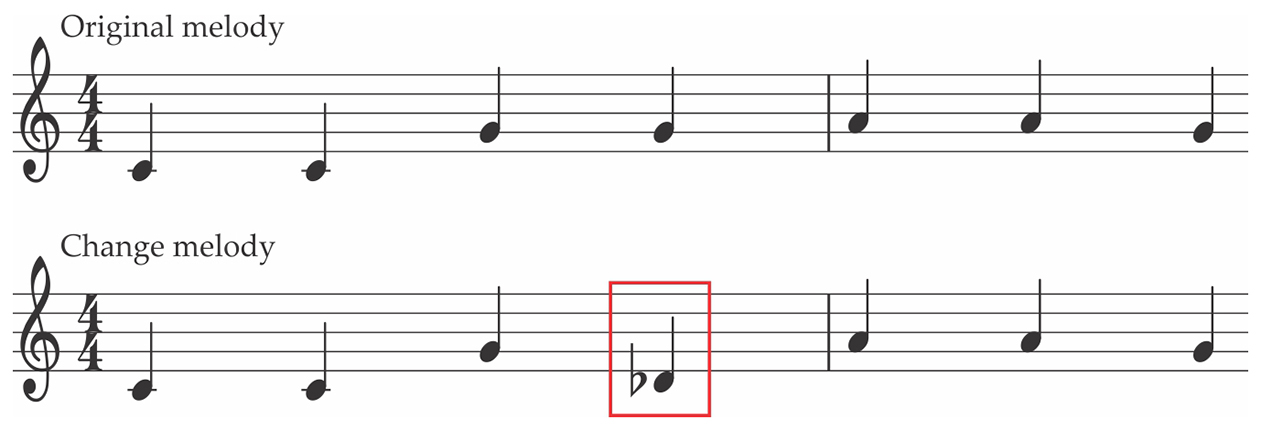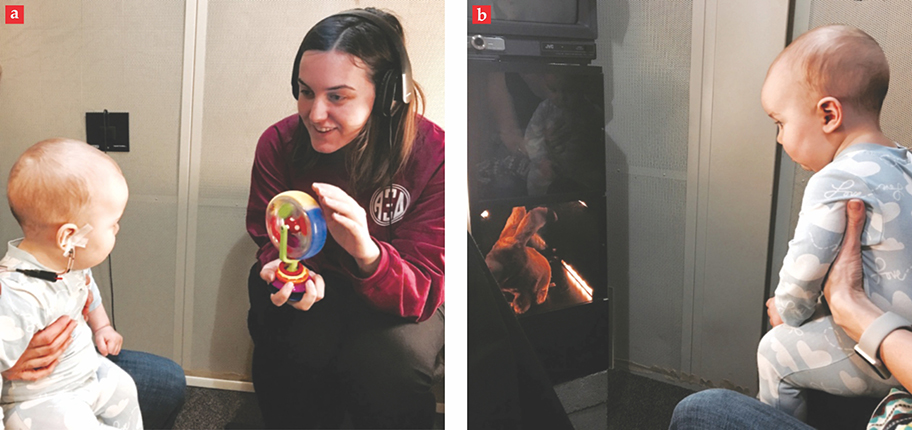Infants note the notes
DOI: 10.1063/PT.3.3637
Pitches are the musical ingredients used for cooking up a good melody. Scientists have long known that pitch is important, not just for perceiving music but also for understanding speech and hearing in noisy environments. But we are still debating how the brain encodes pitch. Neuroimaging studies show activation of the auditory cortex when pitches are presented to adults, so that region of the brain would appear to be involved in pitch processing. Babies do not have a fully developed auditory cortex, but our group’s work at the University of Washington shows that they can nonetheless perceive pitch.
Tones without fundamentals
When an instrument plays a note, it produces a complex sound wave made up of multiple harmonics. The lowest harmonic, or fundamental frequency, carries the pitch, and the harmonic composition determines the note’s timbre. Timbre is the quality that makes a trumpet sound different from a violin.
In our most recent experiment, we tested three-month-old, seven-month-old, and adult participants to see if they could discern a wrong note in the melody of “Twinkle, Twinkle, Little Star” (see figure

Figure 1. Test tunes. In our experiment on melody discrimination, adult and infant participants repeatedly listened to the first few notes of the tune “Twinkle, Twinkle, Little Star.” They learned to respond when they heard the “change melody” with the wrong note shown in the red box. We presented many timbre variations so that timbre would not be a reliable cue for the discrimination task.

You might think that listeners would not perceive pitch in a tone missing its fundamental frequency. But that is not the case, as you can confirm for yourself at, for example, the Auditory Neuroscience webpage www.auditoryneuroscience.com/?q=topics/missing-fundamental
Even though we used tones with missing fundamentals, it is still conceivable that participants were responding to timbre. We therefore randomly varied the timbre for each note. That made the melodies sound as if a different instrument played each one, but it did not alter the pitch of any of them. Therefore, the pitch contour of the melody remained the same. Because of those constantly occurring timbre variations, if participants were responding to timbre rather than pitch, they would get confused—a phenomenon we in fact saw with some adult listeners.
Babies perceive relative pitch
Infants, of course, can’t tell us what they hear, so in our experiment, we assessed auditory perception by observing participants’ responses to the sounds they heard. During testing, infants sat on a caregiver’s lap and, as shown in figure

Figure 2. Babies in a booth. Infants participating in our experiment sat on a caregiver’s lap inside a sound-attenuated booth. (a) An assistant made sure the infant was attentive and facing in the appropriate direction. The infant heard sound through an insert ear tip, but no one else heard what the infant was listening to—the caregiver listened to music and the assistant was receiving instructions from an experimenter who was outside the booth. The experimenter judged whether the infant was presented an altered melody by observing his or her behavior. Common infant responses included head turns or eye darts toward a mechanical animal (b) that had previously been used in a conditioning phase. Adult participants sat alone in the booth. Since infants were not given verbal instructions, the adults got only vague instructions to “raise their hand when they heard the sound change that turns the toys on.” Otherwise, infant and adult testing was the same.

The participants’ task in the experimental trials was to listen for a “change melody” that contained a wrong note. During an initial conditioning phase, the change melody was always followed by the activation of a mechanical toy (see figure
Melodies are built from pitches, and it is possible to listen to a melody and attend to just the absolute pitch cues—the fundamental of each note, independent of the other notes. But what really makes a melody is the pitch relations between its notes. After all, when your hear a melody transposed into a different musical key, you still recognize it even though the absolute pitch of the notes has changed. Melody discrimination requires you to attend to the relative pitch cues that convey the pitch contour.
Past studies had shown that babies can respond to absolute or relative pitch cues depending on the task they are given, so we tested our participants in two ways. In the first set of tests, we always presented “Twinkle, Twinkle, Little Star” in the same key—that is, the pitches stayed the same. In that case, participants had access to both absolute and relative pitch cues. In the second set, we transposed the tune into two additional keys. Each melody presented was randomly selected from one of the three transpositions so that the absolute pitch cues were no longer useful. In both cases, babies were able to discriminate the melodies. In particular, their success in the second set of trials shows that they can use relative pitch cues to extract the melodic contour.
Timbre confusion—it’s an adult thing
Babies learned to associate a wrong note with an activated toy more readily than adults. Most of the infants passed the conditioning phase of our experiment on their first attempt. Many of the adult participants required additional repetitions of the conditioning phase to learn the task, and some couldn’t learn it at all. In the presence of constant timbre change, it appears, some adults have difficulty isolating a changed note and associating it with a reinforcer. Previous studies, including work from our own lab, had also found that adults have difficulty responding to pitch amidst timbre variation. We do not yet understand why such timbre confusion does not affect infants.
Our study indicates that by three months, babies can integrate information from higher harmonics to form a perception of pitch and use it to discriminate musical melodies such as “Twinkle, Twinkle, Little Star” from a change melody with one note altered. The ability of three-month-old infants to perceive pitch suggests that subcortical processing without the involvement of the auditory cortex may be sufficient to encode pitch in the developing auditory system. And now that we know that normal-hearing infants can utilize pitch from such a young age, we may be able to more reliably diagnose infants with impaired pitch perception.
This work was conducted in collaboration with Monika-Marie Oster, Kaylah Lalonde, and Lynne A. Werner. We thank the National Institutes of Health’s National Institute on Deafness and Other Communication Disorders for support.
References
► B. K. Lau, K. Lalonde, M.-M. Oster, L. A. Werner, “Infant pitch perception: Missing fundamental melody discrimination,” J. Acoust. Soc. Am. 141, 65 (2017). https://doi.org/10.1121/1.4973412
► B. K. Lau, L. A. Werner, “Perception of missing fundamental pitch by 3- and 4-month-old human infants,” J. Acoust. Soc. Am. 132, 3874 (2012). https://doi.org/10.1121/1.4763991
More about the Authors
Bonnie Lau is a postdoctoral fellow at the Institute for Learning and Brain Sciences at the University of Washington in Seattle. Manson Ng is a University of Washington alumnus with a master’s degree in computer science and engineering.


